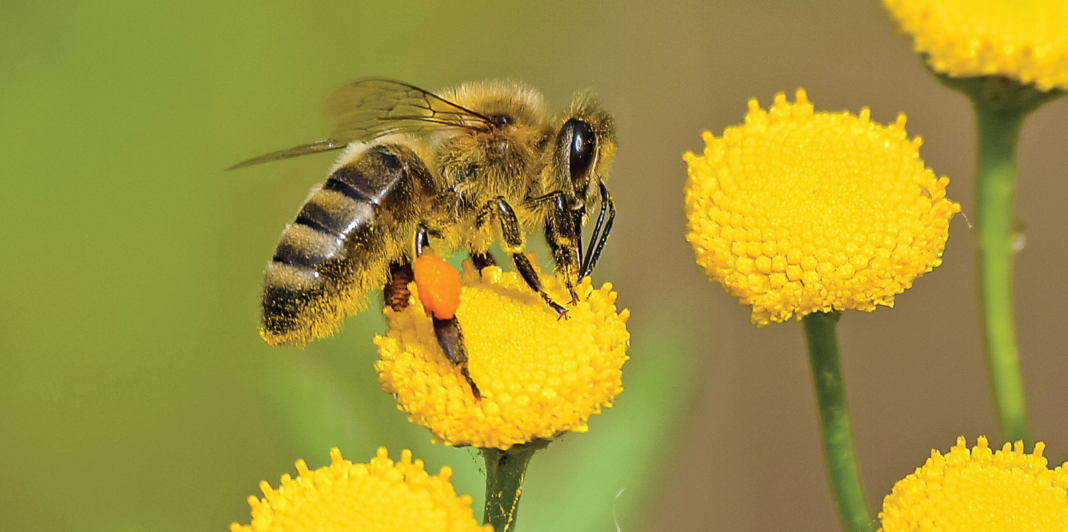Would you believe that mankind’s future on this planet depends on the honey bee? It’s only been in the last few years that I’ve come to realize their importance. I bet you didn’t know that one out of every three bites of the food you eat depends on pollinators like the honeybee. Some of those foods are avocados, asparagus, broccoli, squash, cucumbers, apples, pears, berries, kiwis, cherries, melons, and more! Honey bees play a vital role in the growth of healthy crops as well. Without the natural pollination carried out by bees, it is estimated that the US could lose from one third to one half of its national food supply.
Bees add beauty to our world, too. About 80% of the wildflowers in the US are pollinated by bees. Can you imagine our beautiful country sides without wild flowers?
Bees evolved from wasps about 140 million years ago and there are now about 20,000 species worldwide and about 4,000 in the United States. When this evolution took place, the bees began to switch from prey to pollen.
Bee bodies consist of a head, thorax and abdomen. The head has two antennae that are used to touch and “smell”, two compound eyes and three simple eyes, and mandibles or “jaws” used for biting, working wax and pollen, and digging. The thorax has two pair of wings and three pair of legs. The abdomen consists of six segments in females and seven in males, internal wax glands (only in honey bees and bumble bees), a stinger (only in females), and branched hairs.
Let’s look at two common bees in our area:
Honey bees are social bees and live in colonies. Each bee plays a particular role—drone, worker, and the queen. Drones are the males and their role is to mate with the queen. When winter comes, the drones are kicked out of the hive. The workers are sexually underdeveloped females. They clean the hive, collect pollen and nectar, care for the queen, construct beeswax and guard the entry to the hive. The queen gets chosen at birth and she kills her competition. Her job is to reproduce and she can lay 15,000 eggs in a day!
Each colony consists of hundreds of workers, 50,000 to 60,000 workers and one queen. One bee colony can produce 60 to 100 pounds of honey per year. It is estimated that 29,000 individuals in the USA depend on beekeeping for their livelihood.
There are fifteen species of bumble bees in the US. Bumble bee colonies are quite small and can have from 50 to 400 workers. Bumble bees should be a welcome site in your garden. They are great pollinators of many kinds of flowers. They are very recognizable by their loud buzzing. They are usually black and yellow but can also be red and black or orange and black. The female worker bumble bee can sting but the males can’t; they have no stinger. The bumble bee does not leave its stinger in your skin as honey bees do, and therefore can sting you more than once.
Sadly, bees are disappearing. According to the US Environmental Protection Agency, the bee population in the United States dropped 40 percent from 2014-2015. Why? There are several factors causing the decline. One of the major reasons is habitat loss. In the name of progress, humans destroy natural habitats like meadows and forests to make room for new homes, businesses, schools, etc. Global warming is another reason. More flooding, rising temperatures and drought are affecting the blooming seasons of flowering plants that all affect the bees’ ecosystem. The use of pesticides – including insecticides, fungicides, and herbicides – harm pollinators and other beneficial insects. Parasites, diseases and poor nutrition are also contributing to the decline in bee populations.
What can we do to help save our bees?
• Plant a bee-friendly garden filled with native flowering plants. Many can be purchased at local nurseries.
• Give ‘em some sugar. This one surprised me. Mix a teaspoon of water and two teaspoons of white granulated sugar together on a spoon and put it on a plate in your garden.
• Set a shallow bowl of water in your garden. Bees will drown in bird baths and pools.
• Purchase sustainable honey. Choose only organic honey as well as other organic foods.
• Don’t use synthetic pesticides in your yard and garden.
• Be careful when you weed your garden. Many weeds are beneficial to bees and other pollinators—examples are milkweed and dandelions.
Educate your children on the benefits of bees. They are not to be feared. If bothered, bees may sting but teach your children to simply keep their distance.















